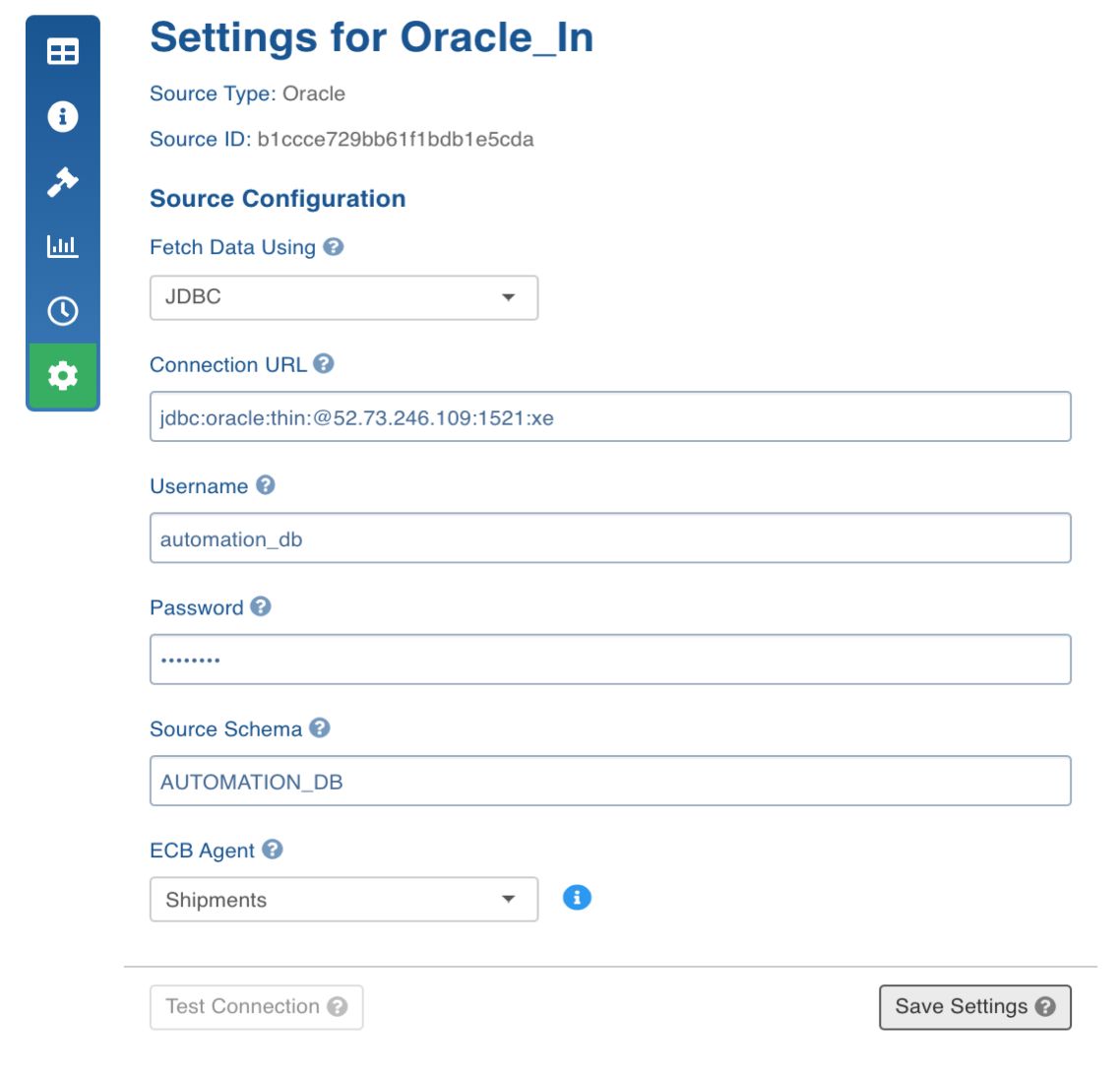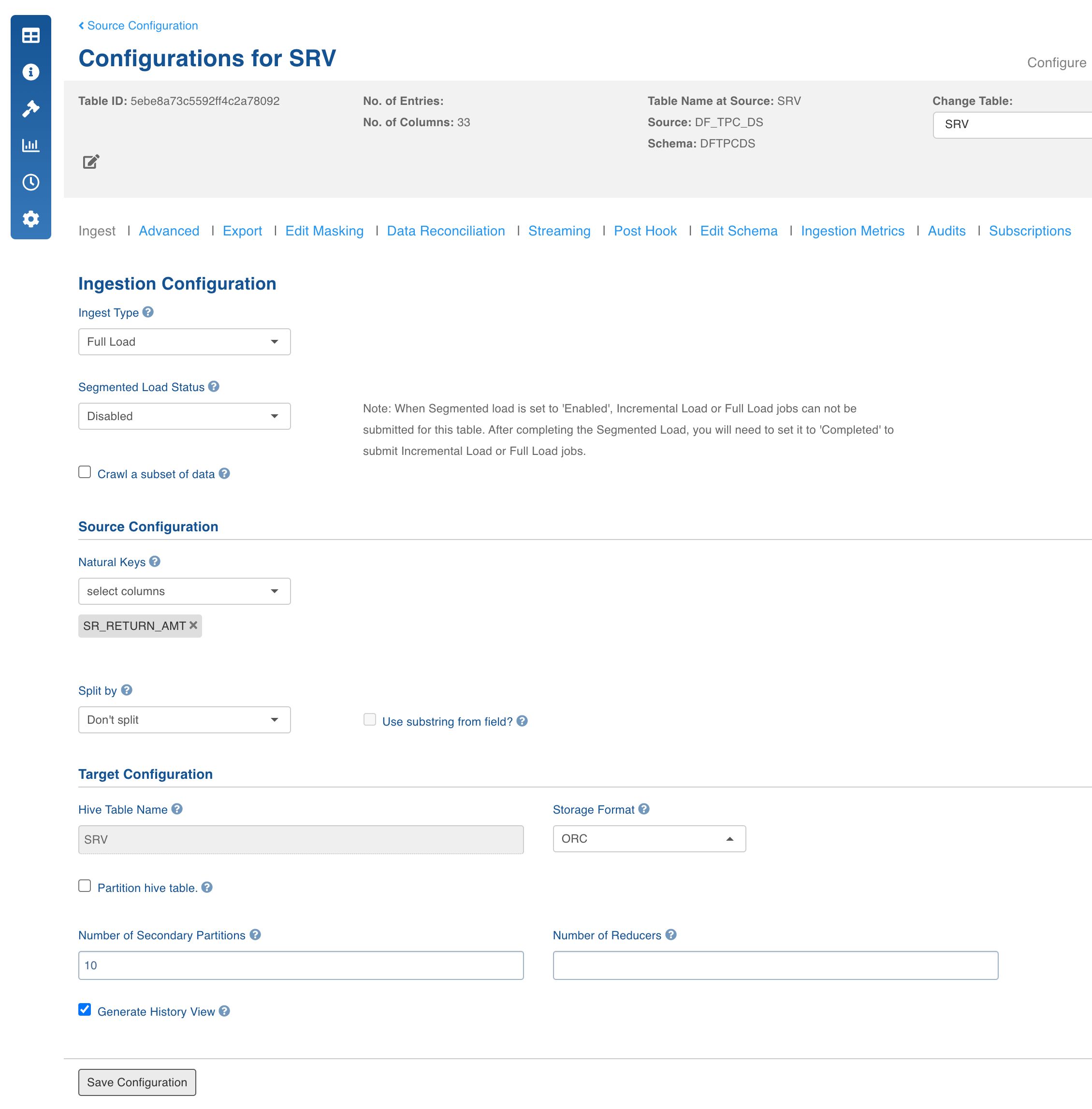Creating Oracle Source
For creating a Oracle source, see Creating Source. Ensure that the Source Type selected is Oracle.
Configuring Oracle Source
For configuring an Oracle source, see Configuring Source.
Oracle Configurations
| Field | Description |
|---|---|
| Fetch Data Using | The mechanism for Infoworks DataFoundry to fetch data from the database. |
| Connection URL | The JDBC URL for Infoworks to connect to the database.
The URL must be in the following format: jdbc:oracle:thin://<ip>/TMODE=<tmode>,database=<databasename> |
| Username | The user name for database connection. |
| Password | The password for the username provided. |
| Source Schema | The database schema to be crawled. |
| ECB Agent | The ECB agent for the source. This field is displayed if ECB agent is enabled for the source. |

Once the setting is saved, you can test the connection or navigate to the Source Configuration page to crawl the metadata.
Crawling Oracle Metadata
For crawling a Oracle source, see Crawling Metadata.
Configuring Oracle Source for Ingestion
For configuring an Oracle source for ingestion, see Configuring Source for Ingestion.
| Field | Description |
|---|---|
| Ingest Type | The types of synchronization that can be performed on the table. The options include Full Load, Timestamp-Based Incremental Ingestion, Query Based Incremental Ingestion, Batch ID Based Incremental Ingestion,Log-Based Incremental Ingestion, OGG Based Incremental Ingestion. |
| Segmented Load Status | The option to crawl large tables by breaking into smaller chunks. The smaller chunks can be crawled in parallel. Select the column to Perform Segmented Load On. To derive a column, check the Use substring from field option and select the Extract function. After completing the Segmented Load, ensure to set this value to Completed to submit Incremental Load or Full Load jobs. NOTE: In case of date, datetime, timestamp column types you can extract new columns. The possible extraction options are year, month, year-month, month-day and day-num-in-month. |
| Crawl a subset of data | This option to crawl a subset of data based on the filter configured. For more details, see Filter Query for Oracle Sources. |
| Source Configuration | |
| Natural Keys | The key to identify the row uniquely. This key is used to identify and merge incremental data with the existing data on target. Distribution of data into secondary partitions for a table on target will be computed based on the hashcode value of the natural key. This field is mandatory for incremental ingestion tables. NOTE: The value of natural key column cannot be updated when updating a row on source; all the components of the natural key are immutable. |
| Split by | The option to crawl the table in parallel with multiple connections to database. Split-by column can be an existing column in the data or derived from an existing column. The numbers, date, datetime and timestamp columns are allowed to be selected as split-by key. In general, any column for which min and max can be computed can be a split-by key. NOTE: Keys which increase or decrease gradually can be used as split-by. To derive a column, check the Use substring from field option and select the Extract function. |
| Enable Boundary Query | The query to use for creating splits. This feature is supported for ECB based RDBMS source also. For details, see the Boundary Query section in the Advanced Ingestion Functionalities. |
| Wide Table | The wide table field must be enabled if table DML statements on the source tables exceed the length of 4000 bytes. This field is available only available for log-based incremental load. |
Synchronization Configuration | |
| CDC Start Date | The option to fetch a specific portion of the delta, based on the time window. The start date of the time window. |
| CDC End Date | The option to fetch a specific portion of the delta, based on the time window. The end date of the time window. |
| Enable Schema Synchronization | The option to synchronize the Hive table schema, if the source table is modified after the table ingestion is complete. |
| Timestamp-Based Incremental Load | |
| Timestamp Column for Insert | The source column to be used as insert watermark. |
| Timestamp Column for Update | The source column to be used as update watermark. NOTE: It can also be the source column to be used as insert watermark. |
| Query-Based Incremental Load | |
| Slowly Changing Dimension Type | The type of the query based ingestion. The options include SCD Type 1 and SCD Type 2. SCD Type 1 always overwrites the existing record in case of updates. |
| Configure Insert Query | The option to input the query which identifies and fetches the incremental insert records from the source table, using the record insertion row from the audit table. |
| Join Column for Insert | The column used to identify the inserts. This column will be joined with audit table column. This field uses source datatype. |
| Configure Update Query | The option to input the query which identifies and fetches the incremental update records from the source table, using the record update row from the audit table. |
| Join Column for Update | The column used to identify the updates. This column will be joined with audit table column. |
| External Audit Schema Name | The schema name of the audit table where the timestamps are being stored. |
| External Audit Table Name | The name of the audit table where the timestamps are being stored. |
| External Audit Join Column | The column by which the data table and the audit table will be joined. |
| External Audit Timestamp Column | The timestamp column in the audit table, which maintains record audit. |
| BatchID-Based Incremental Load | |
| Batch-ID Column | This column used for fetching of delta. This column must be a numeric column. Source datatype and target datatype must be equal. |
| Start Batch Id | The numeric value of Batch ID column (configured by the user during table configurations) starting which the delta is fetched. |
| End Batch Id | Numeric value of Batch ID column (configured by the user during table configurations) till which the delta is fetched. |
| OGG-Based Incremental Ingestion | |
| Username | The username to authenticate the replication database. |
| Password | The password for username provided. |
| Connection URL | The url to connect to the replication database. |
| Source Schema | The schema in the replication database where the captured table is present. |
| Captured Table Name | The name of the table where the actual table data will be replicated. |
| Target Configuration | |
| Hive Table Name | The name of the table in Hive which will be used to access the ingested data. |
| Storage Format | The format of the data file to be stored in HDFS. The options include ORC and Parquet. |
| Partition Hive table | The option to partition the data in target. The partition column also can be derived for date, datetime and timestamp column. This will further partition the data. A hierarchy of partitions are supported with both normal partitions and derived partitions. NOTES: Ensure that the partition columns data is immutable.__You can also provide a combination of normal and derived partitions in the hierarchy. |
| Number of Secondary Partitions | The number of secondary partitions to run the MR jobs in parallel. The target data can be distributed among various partitions and each partitions in turn can have various secondary partitions. A table with no primary partition can also have secondary partitions. Secondary partition helps in parallelising the ingestion process. |
| Number of Reducers | The number of reducers for the ingestion map reduce job. Increasing the number of reducers helps reduce the ingestion duration. This will help in processing the MR jobs faster. This will be effective with the combination of partition key and number of secondary partitions. In any data processing using MR job, this will help in bringing the parallelism based on the data distribution across number of primary partitions and secondary partitions on Hadoop. |
| Generate History View | The option to create history view table (along with the current view table) in Hive, which contains the versions of incremental updates and deletes. |
| Number of Secondary Partitions to Merge in Parallel | The number of secondary partitions that can be merged in parallel for a table. |

Filter Query for Oracle Sources
You can specify complex filter conditions to extract a subset of data from Oracle source tables using the Crawl a subset of data option in the Table Configuration page. This option is used to crawl a subset of data based on the filter configured.
The filter options include the following:
- Filter Column: The column to be filtered.
- Filter Conditions: The filter operator.
- Values: The comparison value.
You can click the Add button to add more filter combinations. The combination conditions include AND and OR.

NOTES:
- Once the table has been ingested, the filter conditions cannot be modified.
- The filter condition cannot be defined on the watermark column.
- Crawling a subset of data is not supported for OGG-based and log-based incremental loads.
References
Oracle Datatypes
For details, see Oracle Data Types.
Configuring Oracle for CDC
For details, see How to Configure Oracle for CDC.
Changing Scale and Precision at Table Level
For details, see How to Change Scale and Precision at Table Level for Table Columns.